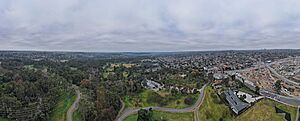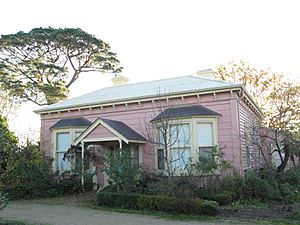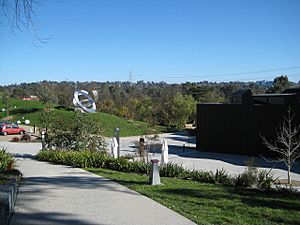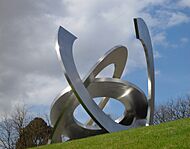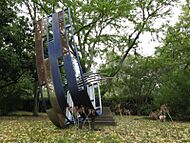Heide Museum of Modern Art facts for kids
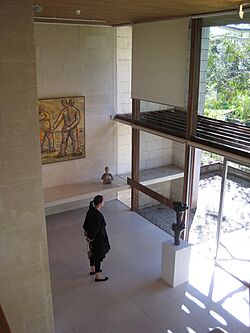
The main gallery space of Heide II
|
|
| Established | 1981 |
|---|---|
| Location | Bulleen, Melbourne, Victoria, Australia |
| Type | Modern art, contemporary art |
| Visitors | 70,000 |
| Public transit access | Route 903 SmartBus from Heidelberg Station |
The Heide Museum of Modern Art, often called Heide, is an art museum in Bulleen. This suburb is part of Melbourne, Victoria, Australia. The museum opened in 1981. It shows modern and contemporary art in three main buildings. The museum is also surrounded by beautiful gardens and a sculpture park. These gardens cover sixteen acres and are very old and special.
Heide used to be a dairy farm. John and Sunday Reed, who loved art, bought it in 1934. They named it Heide because it was near Heidelberg. This area was famous for an art style called the Heidelberg School. Heide became a meeting place for young artists. This group was known as the Heide Circle. Famous artists like Sidney Nolan, John Perceval, Albert Tucker, and Joy Hester often stayed there. They are now some of Australia's most well-known artists. They were also leaders of the Angry Penguins art movement. This movement was named after a magazine that the Reeds helped publish. Heide's art collection shows its strong connection to this important art group.
Between 1964 and 1967, the Reeds built a new house called Heide II. This building is now a great example of modernist architecture in Victoria. In 1980, the Reeds sold most of Heide and many of their artworks. They sold them to the Victorian Government. This was so a public art museum and park could be created. In 1993, a new gallery building, Heide III, was added. It was designed by Andrew Andersons. This building was made even bigger in 2005–06. During this time, the Sidney Myer Education Centre was also built. Heide II and its gardens were also made new again.
Since Heide opened, its art collection has grown a lot. Many people have given artworks to the museum. Heide still supports new and young artists, just as the Reeds wanted.
Contents
Heide's Story
How Heide Began
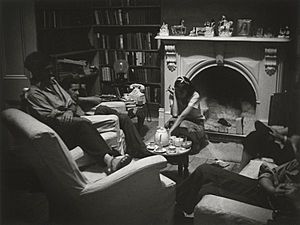
The museum is on land that was first used by Indigenous peoples. There is a special scarred tree on the property called Yingabeal. This tree shows its long history. Later, in the 1800s and early 1900s, the land was a farm. It was used for grazing animals and as a dairy farm. The original farmhouse was built in the 1870s. Artists and writers often visited this area. They loved the Yarra River and hills near Melbourne. Many art groups formed here, like the Heidelberg School.
In 1934, John and Sunday Reed bought the farm. They were big fans of modern Australian art. They named their property Heide after the nearby town of Heidelberg. They moved into the farmhouse in 1935. They created a special library there. It had modern books, art books, and magazines. Heide became a hub for new art and culture. The Reeds welcomed artists like Sidney Nolan, Albert Tucker, Joy Hester, and John Perceval. Sidney Nolan lived at Heide for many years. He painted his famous Ned Kelly series in the farmhouse in 1946–47.
In 1963, the Reeds asked architect David McGlashan to design a new home. They wanted a house that felt mysterious and romantic. It was meant to be "a gallery to be lived in." This new house, Heide II, was built from 1964 to 1967. It was made with light-colored stone and simple materials. The Reeds moved into Heide II in 1967. Sunday Reed also started a new kitchen garden near the house.
Becoming a Museum
The Reeds moved back to Heide I, the old farmhouse. This was after they sold Heide II and many of their artworks. They sold 113 artworks to the Victorian State Government in August 1980. The government agreed to create a public art gallery there. It was named 'Heide Park and Art Gallery'. The inside of Heide II was changed to become a public gallery. It opened in November 1981. Today, the Heide Museum of Modern Art is a non-profit company. A Board of Directors helps manage it for the Victorian Government.
Dr. Norman Wettenhall was the first Chairman. The Premier of Victoria, Sir Rupert Hamer, was the first Patron. Maudie Palmer was the first Director.
Recent Changes
The museum had big changes in 2005–06. Several sculptures and installation art pieces were added. The gardens were also redesigned. A new education center and gallery space were built. The Heide III building was made bigger. This was to show artworks from the Barbara Tucker Gift. On July 13, 2006, the museum officially reopened. It had a $3 million renovation and extension. The new buildings were designed by O'Connor + Houle Architecture.
Heide's Buildings and Layout
Heide is located on land that used to be a floodplain of the Yarra River. It is in Bulleen. The museum has several separate buildings. It also has gardens and parklands. All these areas are used to show art.
Buildings and Facilities
- Heide I
- This is the old farmhouse from the 1870s. The Reeds bought it in 1934. They made it look like a French country house. It was fixed up many times. Today, it shows art from the Heide Collection and Archive.
- Heide II
- The Reeds asked for this building in 1963. It was designed by David McGlashan. It was built from 1964 to 1967. It was meant to be "a gallery to be lived in." The Reeds lived here from 1967 to 1980. It is a top example of modernist architecture in Victoria. It even won an award for being an 'Outstanding Building of the Year'. Now, it shows art from the Heide Collection. Sometimes it features works by modern artists.
- Heide III
- This building was first designed by Andrew Andersons in 1993. It was made bigger in 2005. This added more gallery spaces and storage. It is the museum's largest gallery area. It includes the Central Galleries and other special galleries. It also has the Heide Store.
- Sidney Myer Education Centre
- This center was built in 2005. It was designed to be a place for learning. Teachers, students, and community groups use it. It hosts many programs about Heide's art, buildings, and gardens.
- Heide Cafe
- The cafe reopened in November 2009 after a big renovation. It was designed to fit in with Heide's modern style. The cafe has indoor and outdoor seating.
Gardens and Sculpture Park
Heide's sixteen acres of land have grown over many years. When the Reeds bought the farm in 1934, it was not well cared for. They immediately started working on the kitchen garden. They also planted many trees. They wanted to turn the property into a green park. Today, the landscape includes a sculpture park. It has over forty sculptures. Some of the original gardens are very old and protected. There is also a special area for native plants. You can find many different trees, roses, herbs, and vegetables here.
-
Inge King, Rings of Saturn
-
Dennis Oppenheim, Basket and Wave
Visiting Heide
- Heide I, II and III: Open Tuesday to Sunday, from 10:00 AM to 5:00 PM.
- Heide Store (in Heide III): Open Tuesday to Sunday, from 10:00 AM to 5:00 PM.
- Gardens & Sculpture Park – FREE to visit!
The Heide Art Collection
The main part of the museum's art collection came from John and Sunday Reed. They collected art for over fifty years. Their collection includes many different kinds of art. It has both art that shows real things and abstract art. Some artists in the collection are Moya Dyring, Sidney Nolan, Albert Tucker, Joy Hester, John Perceval, Arthur Boyd, and Charles Blackman.
More to Explore
- Art of Australia
- National Gallery of Victoria
- National Gallery of Australia
- Heidelberg School
- Montsalvat
- Heide Circle
See also
 In Spanish: Museo Heide de Arte Moderno para niños
In Spanish: Museo Heide de Arte Moderno para niños


